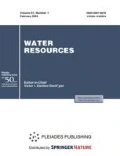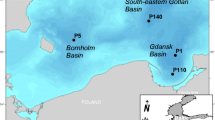Abstract
Long-term observation data (2003–2018) of 625 stations were analyzed to determine the distribution of organochlorine pesticides (DDT, hexachlorobenzene, and hexachlorocyclohexane) and polychlorbiphenyls in bottom sediments of the Barents Sea. The concentrations of pollutants were analyzed for the sea as a whole and separately for six chosen regions: Spitsbergen shelf, Medvezhinskii trough, Northeastern Region, Southeastern Region (the Pechora Sea), the Central Basin, and Kola Bay region. The data were processed with the use of methods of mathematical statistics and GIS-analysis in the ArcView environment (ESRI). Maps of the concentration distributions of the examined pollutants are given. The most polluted were sediments in the central depression and Kola Bay area (including Western Murman), and the least polluted were those in the Southeastern region. The central depression was found to be the main region of pollution deposition in the Barents Sea. A considerable portion of pesticides and PCBs is likely to be the accumulated old pollution that enters the sea because of melting of firn and perennial ice in the Arctic.




Similar content being viewed by others
REFERENCES
Aibulatov, N.A., Matyushenko, V.A., Shevchenko, V.P., Politova, N.V., and Potekhina, E.M., New data on the transverse structure of the lateral flows of suspended matter in the periphery of the Barents Sea, Geoekol., Inzh. Geol., Gidrogeol., Geokriol., 1999, no. 6, pp. 526–540.
Demeshkin, A.S., Geoecological assessment of the state of natural environment near the Russian coal mine Barentsburg in the Spitsbergen Archipelago, Extended Abstract of Cand. Sci. (Geogr.) Dissertation, St. Petersburg: RGGMU, 2015.
Diagnostic analysis of the environmental conditions of the Arctic zone of the Russian Federation (Extended Resume). UNEP, GEF. http://do.gendocs.ru/docs/index-37910.html (Accessed: January 21, 2019).
Zhilin, A.Yu. and Plotitsyna, N.F., Characteristics of the state of pollution of elements of the Barents Sea ecosystem in 2012, Mater. IV Vseros. Nauch.-Prakt. Konf. “Prirodnye resursy, ikh sovremennoe sostoyanie, okhrana, promyslovoe i tekhnicheskoe ispol’zovanie” (Proc. Russ. Sci.-Pract. Conf. “Natural Resources, Their Current State, Protection, Fishery and Technical Use”), Petropavlovsk-Kamchatskii: Izd. KamchatGTU, 2013. Section 4, pp. 156–160.
Zapevalov, M.A., Monitoring persistent organic pollutants—an objective and independent instrument for efficiency assessment of Stockholm Convention on Persistent Organic Pollutants (2001), Khim. Bezop., 2018, vol. 2, no. 2, pp. 295–307.
Zinchenko, A.G., Geomorphological basis for integrated landscape-geoenvironmental studies of the Barents Sea, in Opyt sistemnykh okeanologicheskikh issledovanii v Arktike (Experience in System Oceanological Studies in the Arctic), Moscow: Nauch. mir, 2001, pp. 476–481.
Il’in, G.V., Usyagina, I.S., and Kasatkina, N.E., Geoecological conditions of the marine environment of the Russian Sector of the Arctic under current technogenic load, Vestn. Kar. Nauch. Ts. Ross. Akad. Nauk, 2015, no. 2, vol. 21, pp. 82–93.
Kol’skii zaliv: osvoenie i ratsional’noe ispol’zovanie (Kola Bay: Development and Rational Use), Matishov, G.G., Ed., Moscow: Nauka, 2009.
Lukashin, V.N. and Shcherbinin, A.D., Hydrological properties, suspended matter, and particulate fluxes in the water column of the Bear Island trough, Oceanology, 2007, vol. 47, no. 1, pp. 68–79.
Metodika vypolneniya izmerenii massovoi doli khlororganicheskikh pestitsidov v probakh pochv i donnykh otlozhenii metodom khromato-mass-spektrometrii s izotopnym razbavleniem, (Procedure of Measurements of the Mass Fraction of Organochlorine Pesticides in Samples of Soil and Bottom Sediments by Chromato-Mass-Spectrometry with Isotope Dilution), FSUE Mendeleev Russian Research Institute, cert. no. 242/41-08 of June 16, 1989.
Metodika vypolneniya izmerenii massovoi doli polikhlorirovannykh bifenilov v pochve i donnykh otlozheniyakh metodami gazovoi khromatografii i khromato-mass-spektrometrii (Procedure of Measurements of the Mass Fraction of Polychlorinated Biphenyls in Soil and Bottom Sediments by Gas Chromatography and Chromato-Mass-Spectrometry), NPO Monitoring, Res. Inst. of Hygiene, Prof. Pathol., and Human Ecol., MZMP Ross. Fed., Cert. No. 2420/ 463-97/0463 of June 20, 1997 (M-MVI-09-97).
Mityaev, M.V., Gerasimova, M.V., Pavlova, L.G., and Druzhkova, E.I., Lateral flows of particulate matter in Kol’skii Meridian section, Trans. Kar. Nauch. Ts. Ross. Akad. Nauk, 2018, vol. 9, no. 4, pp. 109–117.
Mityaev, M.V., Khasankaev, V.B., and Golubev, V.A., Toughs of the Barents Sea—present-day transport channels or traps of sedimentary matter? Arkt Antarkt., 2007, no. 5, vol. 39, pp. 72–79.
Novikov, M.A., On the background values of heavy metal concentrations in the Barents Sea bottom sediments, Vestn. Mos. Gos. Tekh. Univ., 2017, vol. 20, no. 1/2, pp. 280–288.
Novikov, M.A., Application of a digital model of bottom sediments of the Barents Sea to the analysis of pollution, Vestn. Kar. Nauch. Ts. Ross. Akad. Nauk, 2018, no. 3, vol. 10, pp. 205–209.
Novikov, M.A. and Draganov, D.M., Spatial distribution of water mass pollution characteristics in the Barents Sea, Water Resour., 2017, vol. 44, no. 5, pp. 768–773.
Ozhigin, V.K., Ivshin, V.A., Trofimov, A.G., Karsakov, A.L., and Antsiferov, M.Yu., Vody Barentseva morya: struktura, tsirkulyatsiya, izmenchivost’ (Water of the Barents Sea: The Structure, Circulation, Variations), Murmansk: PINRO, 2016.
AMAP Assessment 2002: Persistent Organic Pollutants in the Arctic. Arctic Monitoring and Assessment Programme. Oslo: Norway, 2004.
AMAP Arctic Pollution 2009. Arctic Monitoring and Assessment Programme, Oslo, Norway, 2009.
AMAP Assessment 2015. Black Carbon and Ozone as Arctic Climate Forcers. AMAP, Oslo, Norway, 2015.
AMAP Assessment 2016. Chemicals of Emerging Arctic Concern. AMAP, Oslo: Norway, 2017.
Bakke, T., Breedveld, G., Kaellgvist, T., et al., Veileder for klassifisering av miljokvalitat i fjorder ogkystfarvann - Revidering av klassifisering av metaller og organiske miljogifter i vann og sedimenter, SFT Veiledming, 2007.
Breivik, K., Sweetman, A., Pacyna, J.M., and Jones, K.C., Towards a global historical emission inventory for selected PCB congeners—a mass balance approach. 1. Global production and consumption, The Sci. Total Environ., 2002, vol. 290, pp. 181–198.
Chernyak, S.M., McConnel, L.L., and Rice, C.B., Fate of some chlorinated hydrocarbons in arctic and far eastern ecosystems in the Russian Federation, Sci. Total Environ., 1995, vol. 160/161, pp. 75–85.
Eleftheriadis, K., Vratolis, S., and Nyeki, S., Aerosol black carbon in the European Arctic: measurements at Zeppelin station, Ny-Alesund, Svalbard from 1998–2007, Geophys. Res. Lett., 2009, vol. 36, p. L02809.
EMEP, 2010. Persistent Organic Pollutants in the Environment, Shatalov, V., Gusev, A., Dutchak, S., Rozovskaya, O., Sokovykh, V., Vulykh, N., Aas., W. Breivik. K., EMEP Status Rep. 3/2010.
EMEP, 2014. Persistent Organic Pollutants in the Environment, Gusev, A., Rozovskaya, O., Shatalov, V., Aas, W., Nizzetto, P., Status Rep. 3/2014, 2014.
Evenset, A., Christensen, G., Kallenborn, R., and Skotvold, T., The “Bjornoya Case,” Akvaplan-niva report. Tromso, Norway, 2002.
Gyory, J., Mariano, A.J., and Ryan, E.H., The slope/shelf edge current. Surface Currents in the Atlantic Ocean, 2003. https://oceancurrents.rsmas.miami.edu/atlantic/slope.html. Accessed February 14, 2019.
Hansen, B., Osterhus, S., Gould, W.J., and Rickards, L.J., North Atlantic–Norwegian Sea exchanges: the ICES NANSEN project, North Atlantic–Norwegian Sea Exchanges: the ICES NANSEN Project. ICES Cooperative Res. Rep., 1998, no. 225, pp. 3–82.
Hung, H., Katsoyiannis, A.A., Brorstrom-Lunden, E., Olafsdottir, K., Aas, W., et al., Temporal trends of persistent organic pollutants (POPs) in Arctic air: 20 years of monitoring under the Arctic Monitoring and Assessment Programme (AMAP), Environ. Pollution, 2016, vol. 217, pp. 52–61.
Knies, J., Jensen, H.K.B., Finne, T.E., Lepland, A., and Saether O.M., Sediment composition and heavy metal distribution in Barents Sea surface samples: Results from Institute of Marine Research 2003 and 2004 Cruises, Report no. 2006.067. Trondheim: NGU, 2006.
Li, S.M., Talbot, R.W., Barrie, L.A., Harriss, R.C., Davidson, C.I., and Jaffrezo, J.-L., Seasonal and geographical variations of methane sulphanic acid in the Arctic troposphere, Atmos. Environ., 1993, vol. 27A, pp. 3011–3024.
Li, Y.-F., Macdonald, R.W., Jantunen, L.M.M., Harner, T., Bidleman, T.F., and Strachan, W.M.J., The transport of β-hexachlorocyclohexane to the western Arctic Ocean: a contrast to α-HCH, The Sci. Total Environ., 2002, vol. 291, pp. 229–246.
NILU. Monitoring of environmental contaminants in air and precipitation, Annual Rep. 2013. Rep. M202-2014. Oslo, Norway: NILU, 2014.
Ockenden, W.A., Breivik, K., Meijer, S.N., Steinnes, E., Sweetman, A.J., and Jones, K.C., The global recycling of persistent organic pollutants is strongly retarded by soils, Environ. Pollut., 2002, vol. 121, pp. 71–80.
Wania, F. and Mackay, D., Tracking the distribution of the persistent organic pollutants, Environ. Sci. Technol., 1996, vol. 30, p. 390A–396A.
Wania, F., Assessing the potential of persistent organic chemicals for long-range transport and accumulation in polar region, Environ. Sci. Technol., 2003, vol. 37, pp. 1344–1351.
ACKNOWLEDGEMENTS
The author is grateful to colleagues from the Laboratory of Applied Ecology and Toxicology, Polar Branch, N.M. Knipovich Russian Federal Research Institute of Fisheries and Oceanography, A.Yu. Zhilin, N.F. Plotitsyna, and T.A. Zimoveiskova for the invaluable help in the treatment of samples and advices in the discussion of the results of this study.
Author information
Authors and Affiliations
Corresponding author
Additional information
Translated by G. Krichevets
Rights and permissions
About this article
Cite this article
Novikov, M.A. Persistent Organic Pollutants in Barents Sea Bottom Sediments. Water Resour 48, 439–448 (2021). https://doi.org/10.1134/S0097807821030106
Received:
Revised:
Accepted:
Published:
Issue Date:
DOI: https://doi.org/10.1134/S0097807821030106




